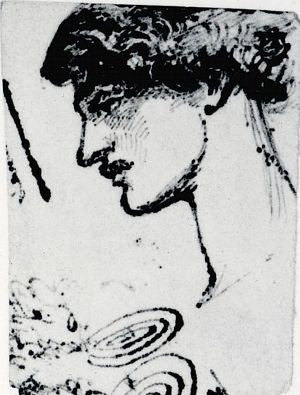Poesis.

(In a very cool turn of events, here's a link to pictures of the church as it appears now. Even cooler, here's a guy playing the church's organ, which was built about a half-century after Van Nickele made his painting. If you've never seen someone playing the organ, you should watch at least a bit of this one. It is so full-bodied an art.)
We had fifteen minutes to take notes on our paintings, then twenty minutes to draft a poem. I couldn't get as close to the painting as I wanted because there was a huge wooden chest on display right underneath the canvas, and for that reason (and so many others) the idea of blockage became part of what I was thinking about.
When I drafted, this is what happened:
The light is the first thing you seeWe all read aloud, fifteen strangers reading the products of thirty-five minutes of looking and writing, and somewhere in there I realized that I was at my first writing workshop ever. It was a good introduction to them, if only because we were such strangers and were together for so little time; there was no time or space for being toxic or unhelpful, for all the nightmares one hears about if one hears about workshops. Nor of course was there time for the truly lovely interactions and collaborations that can come of a well-run, well-bonded workshop group. But there was time to write, time to be listened to, time to be shown we'd been heard--and time to revise.
and then the block.
There is a canvas of light, a hole in the dark wall.
It draws you over to see
the vaulting stone, the way
the arch shapes the light around,
the way the hall --
no, the nave -- is it a nave?
(How is it that you can never remember
the words for a church's parts,
or whether it's a church at all,
instead of a cathedral, or a chapel?
What is that column in the front
of your vision called?
Will you ever learn this thing?
Why are all the windows clear,
tiny panes framing such high light,
such diamonds of pale blue sky?
Why is so much bare?)
Call it a nave.
The way the nave flies over the tiny people
you cannot see until you are closer.
On the museum floor
a dark chest blocks your way, leaves you
leaning and peering for faces,
for hands: the pointing, the glance away,
the changeless smile, the pointless dance.
For revising, we had only about ten minutes. I felt myself having the experience that often bedevils my students when they're learning to write: the end of the piece, the thing to which I'd written, was what I'd been trying to get to all along. And so I decided to put it first.
In their faces' riddles, the vaulting is lost--And then I felt all triumphant because I'd finally gotten myself a bit further away from blocking up my own poem with worries about whether or not I'll ever learn the terms for church architecture, which is such an annoying set of worries anyway. But two women at the table said that they missed the first version's questioning, and another woman started a conversation with me outside the museum after we'd left and said that she, too, had liked the wondering over nomenclature in the first version. Hence the good of a workshop: having an audience, a real one, not a figment of one's own overheated writing imagination.
the bright stone in the dark wall that brought you over
to see how the painted arches shape the painted space,
how the nave flies over the tiny people,
how the tiny panes of sky light his pointing hand.
You could not see these things without getting closer,
but you would not have leaned in without the soaring light.
The barefoot monk dances in shadow.
The blue-dressed woman turns away from her black boy.
The fond man smiles, holds fast to the shoulder
of the pregnant girl who holds her belly, looks away.
So now I'd say I'm brewing again. Much of this weekend goes over to the Cambridge Wordfest, of which I'm taking full advantage. A literary festival in my backyard? Yes, please.


1 Comments:
Hm. I think that I am missing the first version's questions, too. But I think the absence of questions in the revision changes it for the better, and strengthens it.
I do hope that those questions and that questioning turn up in some form of art though. :)
Post a Comment
<< Home